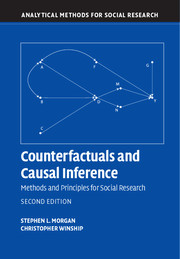Book contents
- Frontmatter
- Dedication
- Contents
- List of Figures
- List of Tables
- Acknowledgments for First Edition
- Acknowledgments for Second Edition
- I Causality and Empirical Research in the Social Sciences
- II Counterfactuals, Potential Outcomes, and Causal Graphs
- III Estimating Causal Effects by Conditioning on Observed Variables to Block Back-Door Paths
- IV Estimating Causal Effects When Back-Door Conditioning Is Ineffective
- 8 Self-Selection, Heterogeneity, and Causal Graphs
- 9 Instrumental Variable Estimators of Causal Effects
- 10 Mechanisms and Causal Explanation
- 11 Repeated Observations and the Estimation of Causal Effects
- V Estimation When Causal Effects Are Not Point-Identified by Observables
- VI Conclusions
- References
- Index
8 - Self-Selection, Heterogeneity, and Causal Graphs
Published online by Cambridge University Press: 05 December 2014
- Frontmatter
- Dedication
- Contents
- List of Figures
- List of Tables
- Acknowledgments for First Edition
- Acknowledgments for Second Edition
- I Causality and Empirical Research in the Social Sciences
- II Counterfactuals, Potential Outcomes, and Causal Graphs
- III Estimating Causal Effects by Conditioning on Observed Variables to Block Back-Door Paths
- IV Estimating Causal Effects When Back-Door Conditioning Is Ineffective
- 8 Self-Selection, Heterogeneity, and Causal Graphs
- 9 Instrumental Variable Estimators of Causal Effects
- 10 Mechanisms and Causal Explanation
- 11 Repeated Observations and the Estimation of Causal Effects
- V Estimation When Causal Effects Are Not Point-Identified by Observables
- VI Conclusions
- References
- Index
Summary
In this chapter, we will lay the groundwork for our presentation of three strategies to estimate causal effects when simple conditioning on observed variables that lie along back-door paths will not suffice. These strategies will be taken up in Chapters 9, 10, and 11, where we will explain instrumental variable estimators, front-door identification with causal mechanisms, and conditioning estimators that use data on pretreatment values of the outcome variable. Under very specific assumptions, these three strategies will identify average causal effects of interest, even though selection is on the unobservables and treatment assignment is nonignorable.
In this chapter, we will first review the related concepts of nonignorable treatment assignment and selection on the unobservables, using the directed graphs presented in prior chapters. To deepen the understanding of these concepts, we will then demonstrate why the usage of additional posttreatment data on the outcome of interest is unlikely to aid in the point identification of the treatment effects of most central concern. One indirect goal of this demonstration is to convince the reader that oft-heard claims such as “I would be able to establish that this association is causal if I had longitudinal data” are nearly always untrue if the longed-for longitudinal data are additional measurements taken only after treatment exposure. Instead, longitudinal data are most useful, as we will later explain in detail in Chapter 11, when pretreatment measures are available for those who are subsequently exposed to the treatment.
Information
- Type
- Chapter
- Information
- Counterfactuals and Causal InferenceMethods and Principles for Social Research, pp. 267 - 290Publisher: Cambridge University PressPrint publication year: 2014
